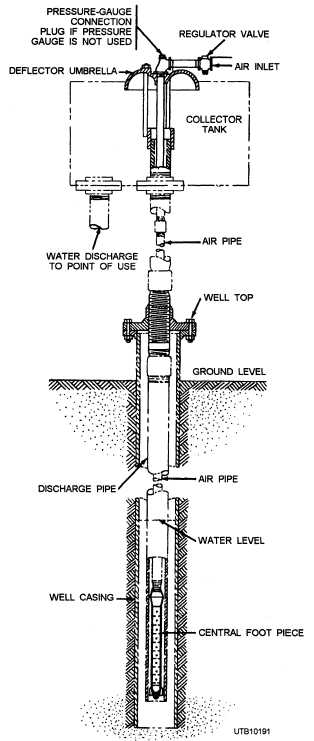When the pump fails to build up pressure and the discharge valve is open and the pump speed is increased, the procedure to use consists of four steps as follows:
1. Secure the pump.
2. Prime the pump and ensure that all the air is expelled through the air cocks on the pump casing.
3. Open all valves on the pump suction line.
4. Start the pump again. If the pump is electric- driven, be sure the pump is rotating in the correct direction. If the discharge pressure is not normal when the pump is up to its proper speed, the suction line may be clogged or an impeller broken. It is also possible that air is being drawn into the suction line or into the casing. If any of these conditions exist, stop the pump, try to find the source of the trouble, and correct it, if possible.
Air-Lift Pumps
Air-lift pumps are used entirely in well pumping. Unlike the pumps studied earlier, the air-lift pump needs no moving or rotating mechanism to produce liquid movement. Instead, the pump uses compressed air to move or lift the liquid.
The air-lift pump operates on the principle that water mixed with air has less weight, or is more buoyant, than water without air. When compressed air is introduced, a mixture of water and air is formed in one leg of the U-shaped pipe, as shown in figure 6-25. The solid column of water in the other leg now has greater weight or is exerting a greater static pressure than the column containing air. Thus the air-water column is forced upward until it discharges over the top of the U-shaped pipe.
In practice, of course, wells are not dug in a U- shape. Figure 6-26 shows a CENTRAL AIR-LIFT PUMP. Compressed air is led down an air pipe to a nozzle or foot piece submerged well below the water

Figure 6-25. - Principles of an air-lift pump.

Figure 6-26. - Central air-lift pump.
Continue Reading